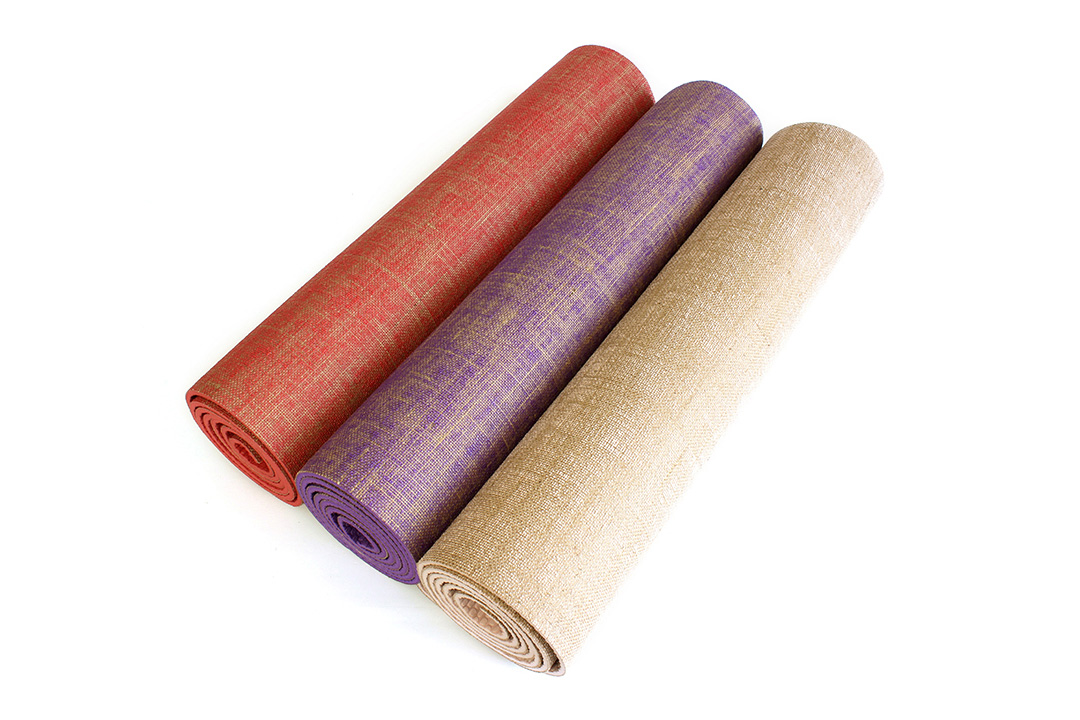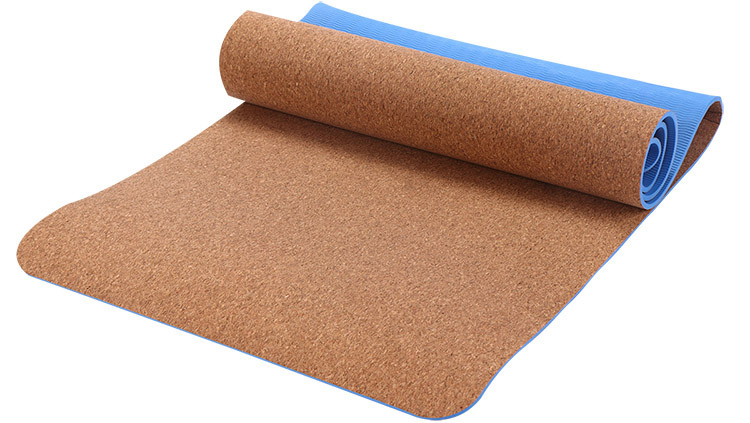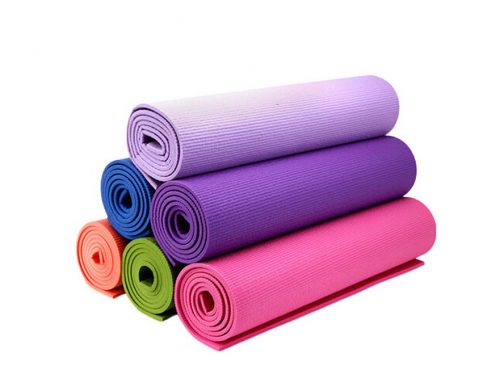Table of Contents
Here we answer a question that has been frequently emailed by yoga fans: What are yoga mats made out of? To put it simply, most of the yoga mats in the market are made from material such as TPE, cork, PVC, PU, natural rubber, NBR, EVA, and jute linen.
As yoga mats of varied types are made from different material, we shall not treat them as the same. This article summarizes the production material of yoga mats in the market to facilitate your understanding towards your mats.
To know more about yoga mat mat manufacturing, please click here: Yoga Mat Manufacturing Process
1. TPE
TPE (Thermoplastic Elastomer) is an eco-friendly material that is both recyclable and reusable and will not pose a threat to the environment after disposal. Yoga mats that are made from TPE feature good elasticity, anti-slip functionality, toughness and strong tension. However, the price of TPE is comparatively higher than its counterparts and is thus mainly in favor of high-end customer groups.
The high price of TPE yoga mats is driven by two factors: the considerably high cost of manufacturing technology and production line input; and the relatively high scrap rate.
2. Cork
Cork, commonly known as water pine, and cork bark, is the outer bark product of a Mediterranean oak tree. Cork is the surface protective tissue of the stem and roots after they have thickened and grown. Cork has outstanding elasticity, sealing, insulation of heat, sound and electricity, and friction resistance. Besides, this material is also non-toxic, soft to the touch, and does not ignite easily, dwarfing other artificial products. These substances are resistant to decay and chemical erosion (except for some strong acid such as nitric acid and sulfuric acids), which means it chemically responses nothing to gasoline, grease, organic acids, salts, esters, etc. Cork is widely used in products like bottle stoppers, life-saving rings and sound insulation boards. Cork yoga mats, soft and comfortable, waterproof and easy to clean, have excellent performance. It is reasonably expected and estimated that cork yoga mats are much more expensive than mats of other material and are favored by high-end customer groups.
2. Cork
Cork, commonly known as water pine, and cork bark, is the outer bark product of a Mediterranean oak tree. Cork is the surface protective tissue of the stem and roots after they have thickened and grown. Cork has outstanding elasticity, sealing, insulation of heat, sound and electricity, and friction resistance. Besides, this material is also non-toxic, soft to the touch, and does not ignite easily, dwarfing other artificial products. These substances are resistant to decay and chemical erosion (except for some strong acid such as nitric acid and sulfuric acids), which means it chemically responses nothing to gasoline, grease, organic acids, salts, esters, etc. Cork is widely used in products like bottle stoppers, life-saving rings and sound insulation boards. Cork yoga mats, soft and comfortable, waterproof and easy to clean, have excellent performance. It is reasonably expected and estimated that cork yoga mats are much more expensive than mats of other material and are favored by high-end customer groups.
3. PVC
PVC (polyvinyl chloride) yoga mats are characterized by good elasticity and anti-slip functionality. Yoga mats of this material are smooth when flat out on the floor and are of a moderate price. As you may have noticed, most of the yoga mats in the market adopt PVC as the manufacturing material.
4. PU
Compared with PVC material, PU (polyurethane) material has better stability, elasticity and less compression variability. In addition, resistant to wear, low temperature, aging and oil, PU material can be used in fields such as shoe industry (synthetic leather) and medical industry. After almost eighty years of technological evolution, PU, which was created in 1930s, has also been widely applied to the field of household goods, daily necessities, and home appliances. When it comes to yoga mats, PU has also been welcomed and become an unique environmental friendly material of mats. PU non-slip mats are not corrosive when they are exposed to the sun, which means it will not corrode other objects despite of slight color fading. Although some yoga mats of PU may have a smell at the beginning, it is still non-toxic and the smell will disappear after a short period of time. More importantly, yoga mats of PU are absolutely anti-slip no matter how wet or dry the mats are. Therefore, when exercising, yoga fans will never fall on the mat or ground due to their sweat or dry skin. And better exercise effect as well as protective property will come out naturally.
In general, a PU yoga mat often contains natural rubber or TPE through the combination of several materials to maximize the advantages of PU.
5. Natural Rubber
Natural rubber is a kind of pure, pollution-free and environmentally friendly material. Yoga mats that are made from natural rubber is ductile, non-slip, resilient and supportive. Besides, they are smooth when flat on the ground, are light in weight and easy to carry.
6. NBR
Through emulsion polymerization method (low temperature condition), NBR (nitrile butadiene rubber) can be made out of butadiene and acrylonitrile. This material has excellent resistance to oil, wear and heat. Despite of its advantages such as strong adhesion. It also contains several shortcomings, including poor low temperature resistance, poor ozone resistance, poor electrical properties, and slightly lower elasticity. The density of submerged TPR is between 1.0 and 1.3; the floating ones are generally between 0.89 and 0.99. In addition, with all its strength, NBR has been widely used in rubber products like soft packaging and cable material, and has become an essential elastic material in fields such as petroleum, auto industry and aviation.
Currently, NBR yoga mats in the market are generally made into 10mm-thick mats, which are suitable for beginners. Although its rebound resilience is slightly lower than that of TPE, its softness is the best among other material and can therefore protect you from injuries when exercising.
7. EVA
Mostly used in the manufacturing of shoe soles, EVA, a heavy smelly material, belongs to the hard foam and is therefore not very suitable for yoga mats. Its elasticity is poor, so does its non-slip effect. But this material is cheap and it also has a foothold in the market.
8. Jute Linen
Pure natural jute linen is moisture-absorbent, wear-resistant and high temperature resistance. Though heavy in weight, this material has the best anti-slip performance among all kinds of material of yoga mats. As the natural jute linen is lack in ductility and is slightly rough, it is often added material such as rubber latex to further improve itself.
There are four factors on which you should keep your eyes:
- Rebound resilience: Press your fingers onto the surface of the mat to see the speed and effect of the upcoming recovery. In general, a good yoga mat can quickly restore its original shape while an inferior one can not and leave a press mark.
- Evenness: Evenness is the key to judging the quality of yoga mats. You can observe the density and evenness of the foaming to judge the mat. The denser and more even the mat, the better it is and the longer service life it will hold.
- Weight: This factor varies with each individual. If you prefer to practice yoga outside, you can buy a TPE one, which is light and easy to carry; if you prefer to use it in a fixed position, than you can pick up a mat of natural rubber, which is much more stable.
- Anti-slip performance: Unfold your yoga mat on the ground and vigorously use the palm of your hand to press the mat forward, if the mat slides on the ground or your hand slides on the the surface of the mat, it means that the mat has poor anti-slip performance. It is best not to use this type of mat.
Do You Want To Make Custom Design Yoga Mat?
Drop Us An Email And You Will Receive Our Feedback Within 24 Hours.
As a leading yoga mat manufacturer, Speck Group focuses on innovation, quality, simplicity, and sustainability.











